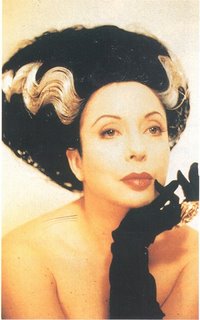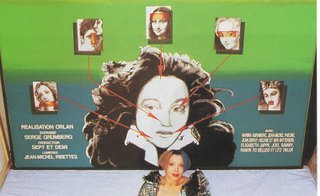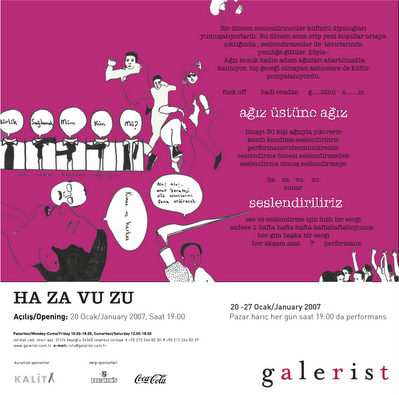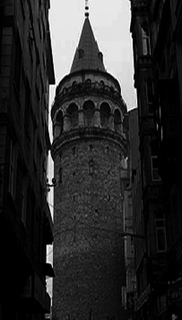 Do our self- representations conform to an inner reality or are they actually carefully contrived falsehoods fabricated for marketing purposes--in the media or in society at large?
Do our self- representations conform to an inner reality or are they actually carefully contrived falsehoods fabricated for marketing purposes--in the media or in society at large?
Orlan is the French intermediatic performance artist, the creator of "
Carnal Art", and a first person who used plastic surgery as a medium of artistic expression.
Born in 1947 in Saint-Etienne, France as Linda Moreno. In 1980 she moved toParis. After experimenting with a variety of media, painting, writing poetry, dance, theatre and photography, in 1964 she started her first street action-performances called
"Slow-motion Walks" during which she took the town’s rush-hour routes in an extremely slow pace. In 1971, she performed
"I am a Man, I am a Woman"Orlan's main medium of art is her own body. In the '70s she did performance pieces in Lyons and, later,outside the Guggenheim Museum in New York. These consisted of abstract measuring actions relating her body to a medieval convent and to a modern art museum. Her subsequent work then came to relate religious iconography to structures of the art world. She challenged both religious traditions and art- world assumptions, the former through blasphemous imagery, the latter with real time/real place actions identifying art with life. High contrast color photographs of Saint Orlan, both living doll and living sculpture, were integrated into photo- collages, videos and films tracing a fictive hagiography.
Convinced that with its exaggerated emotionalism Bernini's St. Teresa in Ecstasy was the first postmodernist sculpture, Orlan found relationships between the forced pathos of Counter- Reformation esthetics and the historical references of contemporary artistic practice. The prototype image of Saint Orlan was a marble sculpture she carved and then, in the tradition of academic sculpture since the Renaissance, sent to be enlarged or "pointed up" to full scale. Her incarnation as Saint Orlan focused on the hypocrisy of the way society has traditionally split the female image into madonna and whore. She played off this long- entrenched dichotomy by exposing only one breast (as the nursing Virgin Mary is depicted), to differentiate Saint Orlan from a topless pinup. (The single exposed breast also referred to the Amazons of ancient mythology, represented as having only one breast to be free to sling warriors' quivers over exposed chests.)
Like many artists of her generation both in France and in the U.S., Orlan was influenced by
Duchamp. Her response was an extreme one: to consider her own body a "
readymade." For more than a decade she has organized performances during which she undergoes plastic surgeries changing her face. Some of them are transmitted live to many places around the world. During the performance the artist talks to the audience, answers the questions, music is played and poetry read.
In 1990, Orlan shed her saintly robes and decided to be "reincarnated" by altering her face and body through a series of carefully planned and documented operations. The idea of turning surgical interventions into performance art occurred to her when she was operated on for an extra- uterine pregnancy under a local anesthetic which permitted her to play the role of detached observer as well as patient.
"I can observe my own body cut open, without suf
fering!... I see myself all the way down to my entrails; a new mirror stage. "I can see to the heart of my lover; his splendid design has nothing to do with sickly sentimentalities"- Darling, I love your spleen; I love your liver; I adore your pancreas, and the line of your femur excites me." (Orlan from Carnal Art Manifesto)
In the course The Reincarnation of Saint Orlan, the artist started to resemble some of the most well known paintings and sculptures including Mona Lisa. With self- transformation in mind, and proceeding with a cold, Cartesian logic buttressed by her considerable knowledge of esthetics and art history, Orlan began to deconstruct mythological images of women. Recalling that the ancient Greek artist Zeuxis made a practice of choosing the best parts from different models and combining them to produce the ideal woman, Orlan selected features -fetishized body parts- from famous Renaissance and post- Renaissance representations of idealized feminine beauty.
Orlan acknowledges a specific debt to Herman

Nitsch and the Viennese "Aktionismus" group that developed in the '60s--artists who startled spectators with their ritualistic staged imitations of blood sacrifices. Of all the Viennese artists, she is perhaps closest to Rudolf Schwarzkogler, who had himself photographed (supposedly) slicing off pieces of his penis as if it were so much salami.
However, there is a crucial difference between the Viennese actions and Orlan's peformances: with them as with many examples of Body art, there was an element of theatrical fakery. The barnyard and the abattoir, not the operating room, provided blood for the Viennese performance artists. "Documentary" photographs were frequently staged: Schwarzkogler did not bleed to death any more than Schwarzenegger's on-screen blood is real. (Nor did Yves Klein jump out a window.)
She aims to exorcise society's program to deprive women of aggressive instincts of any kind. During the process of planning, enacting and documenting the surgical steps of her transformation, Orlan remains in control of her own destiny. Orlan the artist and the woman will never play the victim: she is both subject and object, actress and director, passive patient and active organizer.
The new image after the plastic surgery is to be seen. However, Orlan radically changes this and shows what is to be hidden. The blood, tissues... all the materiality of human body. This way she refutes the devinely, perfect image attributed to women.
For more information on Orlan:
Orlan: Is this art? by Barbara RoseOrlan's web site






